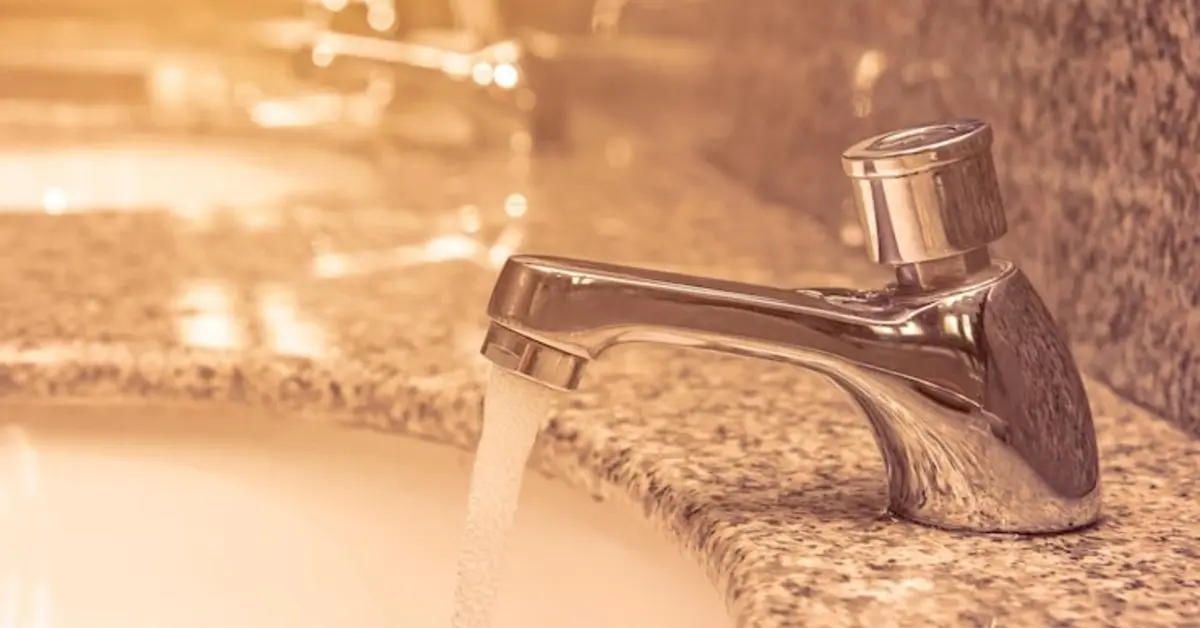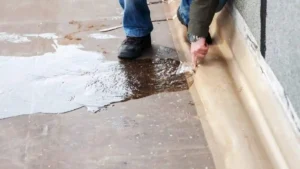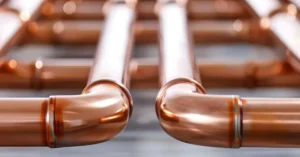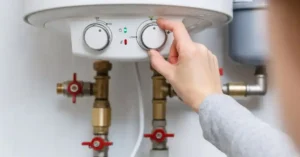You turn on your tap expecting clear water, but muddy brown liquid flows out instead. This common problem startles homeowners and raises immediate health concerns. The good news is that the brown water coming out of faucet issues usually have simple explanations and fixable solutions.
Brown discoloration in your tap water typically stems from rust, sediment buildup, or maintenance work in your area. While alarming to see, most cases pose minimal health risks. Understanding the root cause helps you take the right action quickly.
Why Is the Brown Water Coming Out of Faucet

Brown water appears when rust particles, minerals, or sediment enter your home’s water supply. Your plumbing system contains metal pipes that corrode over time. This corrosion releases iron oxide, commonly known as rust, into the water flowing through your taps.
The discoloration can affect your entire house or just specific faucets. If brown water from the faucet appears only when you first turn on the tap, the problem likely exists within your home’s pipes. When the issue affects multiple homes in your neighborhood, the municipal water system is usually responsible.
Water utilities sometimes flush fire hydrants or repair main water lines. These activities stir up sediment that has settled in distribution pipes. The disturbed material then travels through the system to your home, causing temporary discoloration.
Common Causes of Brown Water Coming Out of a Faucet
Corroded Pipes
Older homes built before 1960 often have galvanized steel pipes. These pipes develop rust as their protective zinc coating wears away. Iron and steel pipes gradually corrode from the inside out, releasing rust particles into your water supply.
The hot water heater accelerates corrosion because heat speeds up chemical reactions. This explains why brown hot water appears more frequently than discolored cold water. Your water heater’s anode rod may be depleted, causing the tank itself to rust.
Sediment in Water Heater
Water heaters accumulate mineral deposits and sediment at the bottom of the tank. Calcium, magnesium, and other minerals separate from heated water and settle. This buildup gets disturbed when water flows, mixing rust-colored sediment into your hot water supply.
Regular flushing prevents sediment accumulation. Most manufacturers recommend draining your water heater annually. Neglecting this maintenance causes the sediment layer to grow thicker each year.
Municipal Water Main Work
City water departments perform routine maintenance on distribution systems. When crews repair broken mains or replace aging pipes, they temporarily shut off water flow. Restarting the system stirs up rust and sediment that has accumulated in the lines.
Fire hydrant flushing is another common municipal activity. Water departments open fire hydrants to test their functionality and clean out the water mains. The high-flow operation dislodges buildup from pipe walls, sending it downstream to homes and businesses.
Well Water Issues
Private well systems pull water from underground aquifers. Heavy rain can wash surface material into your well, causing temporary discoloration. Iron bacteria thrive in wells and create rust-colored slime that contaminates the water supply.
The well pump may be drawing water from a different depth than usual. Sediment layers at certain depths contain more minerals that discolor water. A damaged well screen allows sand and sediment to enter your plumbing system.
Disturbed Rust Buildup
Years of rust accumulation inside pipes creates a stable layer on pipe walls. Sudden changes in water pressure or flow direction can break loose this buildup. Construction work, water main breaks, or even your neighbor’s heavy water usage can create pressure fluctuations.
The rust particles then flow through your plumbing system until they exit through faucets. This type of brown water coming from faucets typically clears up within a few hours as the disturbed material flushes out.
Is Brown Water Dangerous?
Brown water from rust poses minimal health risks in most situations. Iron is an essential mineral your body needs. The amounts present in discolored tap water rarely exceed safe consumption levels. The Environmental Protection Agency sets a secondary standard of 0.3 milligrams per liter for iron, primarily for aesthetic reasons rather than health concerns.
However, brown water can harbor bacteria if the discoloration comes from a contaminated source. If your water smells foul, has an oily appearance, or contains visible particles, avoid drinking it. Municipal water systems must meet safety standards, but private wells require regular testing.
The water from faucet is brown but still safe for showering and washing dishes in most cases. Rust stains clothing and fixtures, creating frustrating cleaning problems. White laundry can turn orange, and bathtubs develop stubborn brown rings.
People with compromised immune systems should exercise extra caution. Contact your water provider to confirm the water meets safety standards before consuming discolored water. When in doubt, use bottled water for drinking and cooking until the issue resolves.
How to Fix Brown Water Coming Out of Your Faucet
Run Cold Water First
Turn on your cold water taps and let them run for several minutes. Start with the faucet closest to your main water line. This action flushes sediment from your pipes without drawing from your water heater.
If the water comes out brown initially but clears up, the problem exists in your distribution lines. Municipal issues typically resolve within 20 to 30 minutes of flushing. Run all cold water faucets simultaneously to speed up the process.
Flush Your Water Heater
Annual water heater flushing prevents sediment buildup and extends tank life. Turn off the power or gas supply to your water heater. Connect a garden hose to the drain valve at the bottom of the tank.
Open the drain valve and let water flow until it runs clear. The first water will likely appear brown and contain visible sediment. Continue draining until the water looks clean, which may take 10 to 20 minutes.
Close the valve and refill the tank before restoring power. This simple maintenance task eliminates most hot water discoloration problems. Consider replacing the anode rod if your water heater is more than five years old.
Check With Neighbors
Ask nearby residents if they experience similar water discoloration. Widespread brown water indicates a municipal problem rather than an issue specific to your home. Your water utility may already be aware of the situation and working on repairs.
Contact your water department to report the problem and get updates. They can confirm whether maintenance work caused the discoloration and provide an estimated resolution time. This information helps you decide whether to wait or take further action.
Replace Old Pipes
Homes with galvanized steel pipes eventually need repiping. These pipes have a lifespan of 40 to 70 years. If your home is older and experiences frequent brown water problems, corroded pipes are likely the culprit.
Modern plumbing uses copper or PEX pipes that resist corrosion. While repiping represents a significant investment, it eliminates chronic water quality issues. The project also prevents pipe leaks and increases your home’s value.
Install a Water Filtration System
Whole-house water filters remove sediment, rust, and other particles before water reaches your faucets. These systems install at your main water line and protect all fixtures. Sediment filters capture particles as small as 5 microns.
Point-of-use filters work for specific faucets if you want a more affordable solution. Under-sink systems provide filtered water for drinking and cooking. Replace filter cartridges according to manufacturer recommendations to maintain effectiveness.
Test Well Water
Private well owners should test their water annually. A comprehensive analysis checks for bacteria, minerals, and contaminants. High iron content requires specialized treatment systems.
Iron filters use oxidation to convert dissolved iron into particles that get trapped in a filter media. Water softeners remove minerals that contribute to discoloration and hardness. Professional well services can recommend appropriate treatment based on your test results.
Preventing Future Brown Water Problems
Prevention is easier and cheaper than dealing with recurring brown water issues. Regular maintenance keeps your plumbing system healthy and your water clear.
Schedule Annual Water Heater Maintenance
Drain your water heater every 12 months to remove sediment. This simple task takes 30 minutes and prevents most hot water discoloration. Mark your calendar or set a reminder on your phone.
Check the anode rod every three to five years. This sacrificial component protects the tank from corrosion. Replace it when more than six inches of the core wire is exposed. A new anode rod costs $20 to $50 and extends your water heater’s life significantly.
Monitor Your Pipes
Inspect exposed pipes in your basement or crawl space regularly. Look for rust spots, moisture, or mineral deposits on the exterior. Early detection allows you to address problems before they cause brown water or leaks.
Pay attention to changes in water pressure or flow. Reduced pressure often indicates pipe buildup or corrosion. Addressing these signs early prevents more serious plumbing system failures.
Install Pressure Regulators
High water pressure accelerates pipe corrosion and loosens rust buildup. Most homes function best with water pressure between 40 and 60 PSI. A pressure regulator protects your pipes and appliances from damage.
Test your water pressure with an inexpensive gauge available at hardware stores. If pressure exceeds 80 PSI, install a regulator on your main water line. This device costs $50 to $350 installed and saves money on repairs long term.
Use Water Softeners in Hard Water Areas
Hard water contains high levels of calcium and magnesium. These minerals accelerate pipe corrosion and create scale buildup. A water softener removes these minerals and protects your plumbing system.
Softened water also extends appliance life and improves cleaning effectiveness. Your water heater operates more efficiently without mineral buildup. Soap and detergent work better in soft water, saving you money on cleaning products.
You can read about: How Do I Repair a Leaky Bathtub
When to Call a Plumber
Professional help becomes necessary when simple fixes don’t resolve brown water problems. If flushing your taps and water heater fails to clear the discoloration after 24 hours, underlying issues require expert diagnosis.
Persistent brown water in hot water only suggests water heater problems. A corroded tank or failed anode rod needs professional replacement. Attempting DIY water heater repairs can be dangerous due to high temperatures and pressure.
Multiple plumbing problems alongside brown water indicate serious pipe corrosion. Low water pressure, frequent leaks, and visible rust on pipe exteriors signal that your plumbing system needs professional evaluation. Delaying repairs can lead to costly water damage.
Strange odors accompanying brown water require immediate attention. Sulfur smells indicate bacteria growth. Chemical odors suggest contamination that poses health risks. Professional plumbers have testing equipment to identify the exact problem.
Contact with Professional Plumbers at Derks Plumbing
Derks Plumbing provides expert solutions for water quality and plumbing problems throughout the Los Angeles area. Our licensed technicians diagnose brown water issues quickly and recommend cost-effective repairs. We handle everything from simple water heater flushes to complete pipe replacement projects.
Our team stays updated on local water quality issues and building codes. We use quality materials and proven techniques to ensure lasting results. Same-day service is available for urgent plumbing problems that disrupt your daily routine.
Need help with brown water or other plumbing concerns? Our specialists offer comprehensive Faucet Repair in Los Angeles and surrounding communities. Contact Derks Plumbing today for a free estimate and experience the difference that professional service makes.
Conclusion
Brown water coming out of faucet problems usually has straightforward causes and solutions. Most cases result from rust in pipes, sediment in water heaters, or municipal maintenance work. While the discoloration looks unpleasant, it rarely poses serious health risks.
Start troubleshooting by running your taps to flush the system. Maintain your water heater with annual draining. Contact your water department to rule out municipal issues. For persistent problems, professional plumbing services provide expert diagnosis and permanent fixes.
Taking action quickly prevents rust stains on fixtures and clothing. Regular maintenance keeps your plumbing system healthy and your water clear. When simple solutions don’t work, experienced plumbers have the tools and knowledge to restore your water quality.
FAQs
How long does brown water last?
Brown water from municipal work typically clears within 30 minutes to a few hours. Flush your cold water taps to speed up the process. Problems lasting more than 24 hours indicate issues within your home’s plumbing that need professional attention.
Can I shower in brown water?
Showering in brown water is generally safe but not ideal. The rust won’t harm your skin, but it can stain light-colored hair temporarily. Use a shower filter if brown water is a recurring problem in your area.
Does brown water mean my pipes are failing?
Not always. Temporary brown water from municipal work doesn’t indicate pipe problems. Frequent or persistent discoloration suggests pipe corrosion that may require replacement, especially in older homes with galvanized steel pipes.
Why is only my hot water brown?
Brown hot water points to sediment buildup in your water heater tank. The heating process accelerates corrosion and mineral separation. Flushing your water heater usually resolves this problem. Consider replacing an older unit if flushing doesn’t help.
Should I drink brown water?
Avoid drinking brown water until you determine the cause. Municipal water that’s brown from maintenance work is usually safe once it clears. Private well water needs testing to ensure safety. Use bottled water until you confirm your tap water meets safety standards.
How much does it cost to fix brown water?
Costs vary based on the cause. Flushing your water heater costs nothing if you do it yourself. Professional water heater service runs $100 to $300. Pipe replacement for a whole house ranges from $4,000 to $15,000 depending on home size and pipe material.












